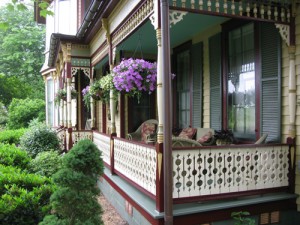 Whether you are restoring a National Register property or if you live in a historic district you will have to seek the approval of a committee to restore, renovate or replace the materials used on your front or back porch. In many cases your historic committee or your architectural review board is looking out for the best interest of your historic property. Their goal is to preserver the historic and architectural integrity of the property. In many cases they do a really great job. In some cases the phrase preserve or and maintenance are words that some committees completely forget.
Whether you are restoring a National Register property or if you live in a historic district you will have to seek the approval of a committee to restore, renovate or replace the materials used on your front or back porch. In many cases your historic committee or your architectural review board is looking out for the best interest of your historic property. Their goal is to preserver the historic and architectural integrity of the property. In many cases they do a really great job. In some cases the phrase preserve or and maintenance are words that some committees completely forget.
The reality of historic preservation is… in many cases, there are no longer acceptable wood materials available to use to preserve these historic properties. For example: Many individuals and contracts have contacted us over the years perplexed by their failing wood porch. The conversations usually start out something like this; “We are looking to replace our porch and we cannot figure out why we are having to do it again after only 4 years. You see, my grandmother had this house built and for almost 100 years the porch has never been replaced. About 4 years ago we installed a wood product similar to what was on it before and now we are replacing it again. Why did the previous porch last 100 years and these last one only 4 years.?”
The short answer is, the wood used to replace 100 year old porches is nothing like the dense vertical grain wood products used 100 years ago. On top of the density, we are no longer using lead based paints nor are we using strong treating chemicals. Wood today is cut as quickly as it can possibly be cut. It is rushed to the mill. It is cut down and ripped in to T&G profiles. It spends about 45 minutes being treated if it is pine and little to no time being treated if it is Douglas fir. All in all, wood is no longer what it used to be. 
With this understanding, we created the Aeratis tongue and groove porch flooring line. Aeratis is exactly the same profile as wood was 100 years ago. It can be cut like wood. It can be routed like wood. It is installed easier and faster than wood. When the Traditions product line is painted, you cannot tell it is not wood. As seen to the right, when Aeratis Traditions is painted not only does it look like wood, will never buckle, cup, check, rot or deteriorate. If you use a recomended paint, the paint is free in the form of a rebate and the repaint cycles are typically every 7 to 10 years.
If you are looking to preserve your historic home or if you are on a committee and you are looking for a solution for inferior wood products, please contact us and we can help you.
Content is currently being added to this page. Please check back later if you cannot find what you are looking for…
French Quarter Resources – Aeratis Traditions has recently been approved by The Vieux Carré Commission. Click here for all resources and information about this approval.
Louisiana Resources – Approval by the State for National Register T&G wood replacement. View
